Of Mantas And Moken
Diving With Giant Mantas In Myanmar
Patrick Carpenter
You step off the back of the boat into a realm of blue. There is little shock – the water’s warm at the surface. Back on land, people are rising and rolling out of bed. You are dropping deeper, losing air, losing buoyancy, sinking out of the white light and through the layer of tropic blue, down, down, down. Beyond twenty meters, then thirty, where violet fades to midnight. At this depth, there is no red; colours dull, greens and browns just above, and the smaller, wildly painted fish are all well above your head, darting around skittishly in the sunlight.
You trade the windswept chop of the surface for the deeper, thicker current. It is the current more than the creatures that you have to be aware of. Most stories of divers lost at sea have something to do with strong currents – either falling unobserved off the back of a moving boat, or separating from the group underwater, slipping into a different current. Fruitless searches all ending with ‘…and they were never seen again.’
You are in the Mergui Archipelago, in Myanmar waters, at a site no more than a speck on the local nautical map. The black, chiseled clod of rock is six hours from the nearest community – that of the Moken, Myanmar’s sea gypsies – and fifteen hours by speeding boat to the first decompression chamber. Tomorrow you will see your first bird in three days, a bird the size of a child’s fist, clinging to the scruff on the top of the black rock. Otherwise, society is confined to the boat. Deep in the distance, solitary fisherman in their rail-thin longtail boats speckle these waters – some with nets, some with explosives, all with only the most meagre protection from the elements. Hard lives here in relentless salt and sun.
You are one of nineteen divers, including one manta expert, and six boat staff, including one captain, one cook, and one steward, who have travelled three days together as part of the Ray of Hope Expedition to track the Manta birostris – the giant manta ray. Individuals in the group have travelled from as far away as Europe, America, Australia … and Phuket. The distances combined to get to this moment are impressive, and add to the enormity of expectation.
The reef is on your right, the open ocean to your left and beyond the reef tapers out and the ledge drops off into a canyon. On this dive you have two choices: you can comb the reef, with its moray and white-eyed eels, its octopuses, fan corals, zig-zag oysters, the beautiful but horribly named varicose wart slug, the beautiful and perfectly named oriental sweetlips, the blue line and honeycomb groupers, glassfish, emperor fish, fusiliers, snappers … or you can move out and away, into the current and towards the edge of midnight, and gamble your air on the chance of a giant manta.
You drop down to 32m and stare out, listen to your Vader-like breathing, try to slow it down. Always with diving it is about conserving air and energy. The rest of your group are posted like sentries, looking hard into the void, plumes of air bubbles from each escaping upwards. Time burns. You check your dive computer. How much longer at this depth? Burning air, burning time.
Deep in the distance, solitary fisherman in their rail-thin longtail boats speckle these waters – some with nets, some with explosives, all with only the most meagre protection from the elements. Hard lives here in relentless salt and sun.
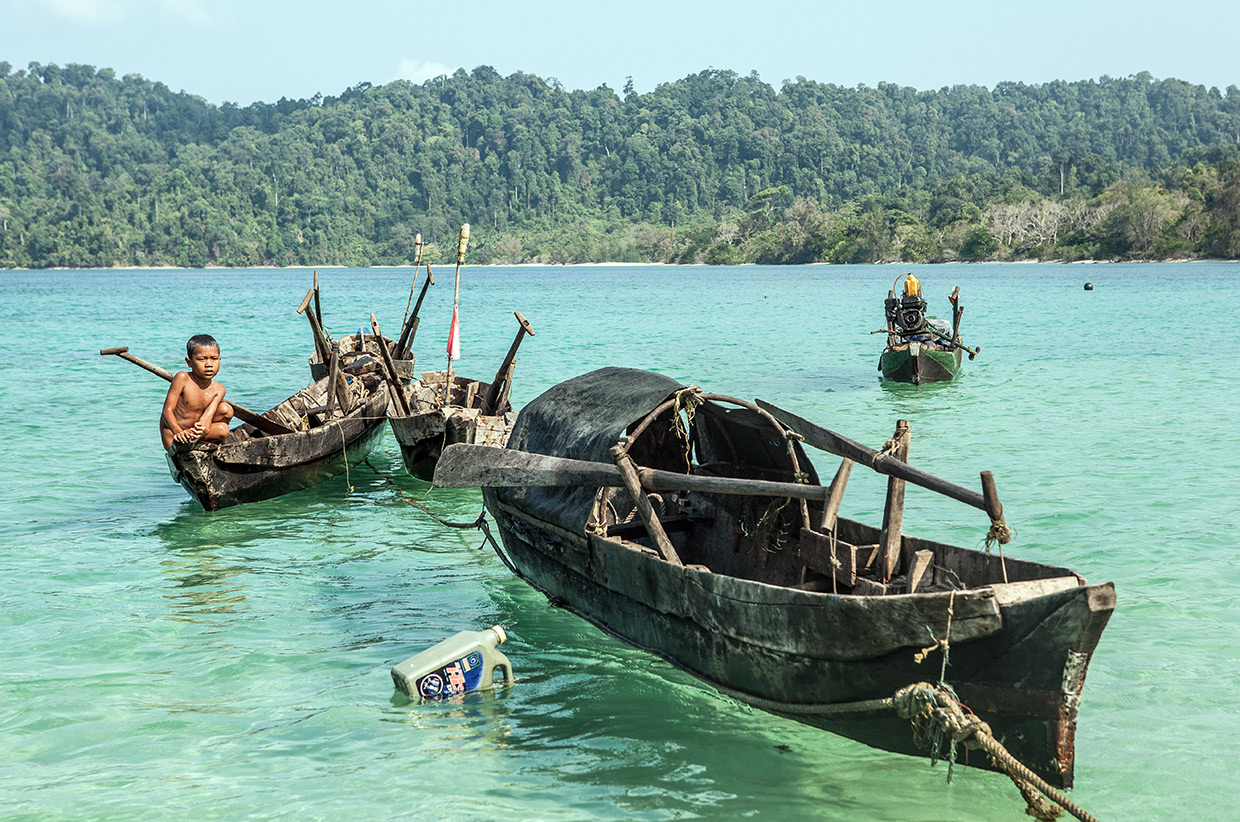

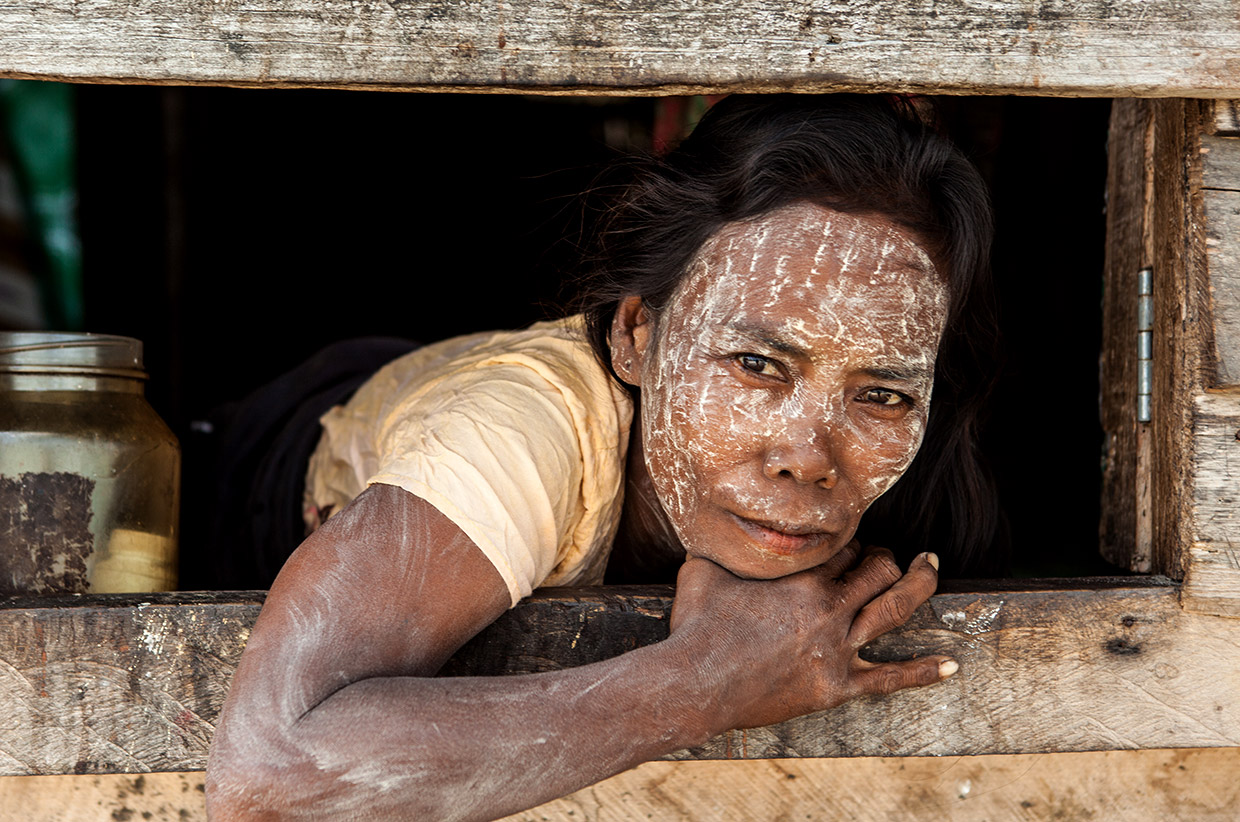
At this depth, there is only liquid darkness and the hollow metallic sucking of oxygen out of your tank into your mouth. Each breath one less in the tank, each breath louder in your head.
How far can you actually see, when there is nothing to gauge the distance? The water is heavy with plankton, but it actually flattens perspective, like stargazing. Beyond what you can see is simply more that you can’t. There are no landmarks, just the liquid density of colour. Look up to the surface: it’s pure light, morning sunbeams piercing, silver surface dancing. But look straight out and it’s permanent midnight. And in between, the full spectrum of blue.
This is it, then: off away from the rock, at this depth, there is only liquid darkness and the hollow metallic sucking of oxygen out of your tank into your mouth. Each breath one less in the tank, each breath louder in your head. So it slowly goes, and goes, and goes. The minutes fall, you check your air, you check your depth, you watch the numbers trickle up and down as you inhale and exhale in the current. You stare down past your fins. You stare at the surrounding nothing. You check the body language of the others.
From inside the midnight, a flicker of white. The uplifted tip of a wing. Your dive leader taps on his tank with his baton – sound travels faster through water than air – and all masks align like searchlights, first to his outstretched arm, then straight on from his finger to that tip.
Confirmed.
The first manta appears at approximately 7.40 on Tuesday morning at a depth of around 35m, silently cruising in and out of focus. Black on top, white on bottom, mouth forever open, the giant manta doesn’t swim. It soars, it glides, it flies – all the verbs of the air and for good reason. It has the manner of the wandering albatross, not a shark or fish. In essence it’s a kite without a string, or wings without the means to land. A giant manta’s wingspan can exceed six metres – the largest reach a seven-metre span. There is a slight bump on its otherwise thin whip of a tail that links it distantly to the stingray, but it has no barb and therefore no defence other than flight.
Unlike most fish, mantas have no air bladder to regulate their buoyancy at different depths and to resonate sound. They are therefore like the shark: ships without ballast, without voices. The lack of this bladder enables the manta to dive down beyond 500m – useful when fleeing predators or feeding in rich ocean depths. Also like the shark, the manta draws its oxygen from the water pouring into its open canyon of a mouth and through the gills. This means that the manta (and shark) must keep moving to keep living. Any extended observation and interaction with us is therefore limited, increasing the mystery that surrounds them – these silent ships passing, where have they been, where do they go, and why?
You sense that the manta is aware of you, individually and collectively. It seems both wary and unconcerned. The manta can out-swim a shark, so what danger could a human – weighed down with nitrox and oxygen tanks, the weight belts, the fogged and leaky masks, the neoprene, lycra, silicone, rubber – what threat could a human really present?
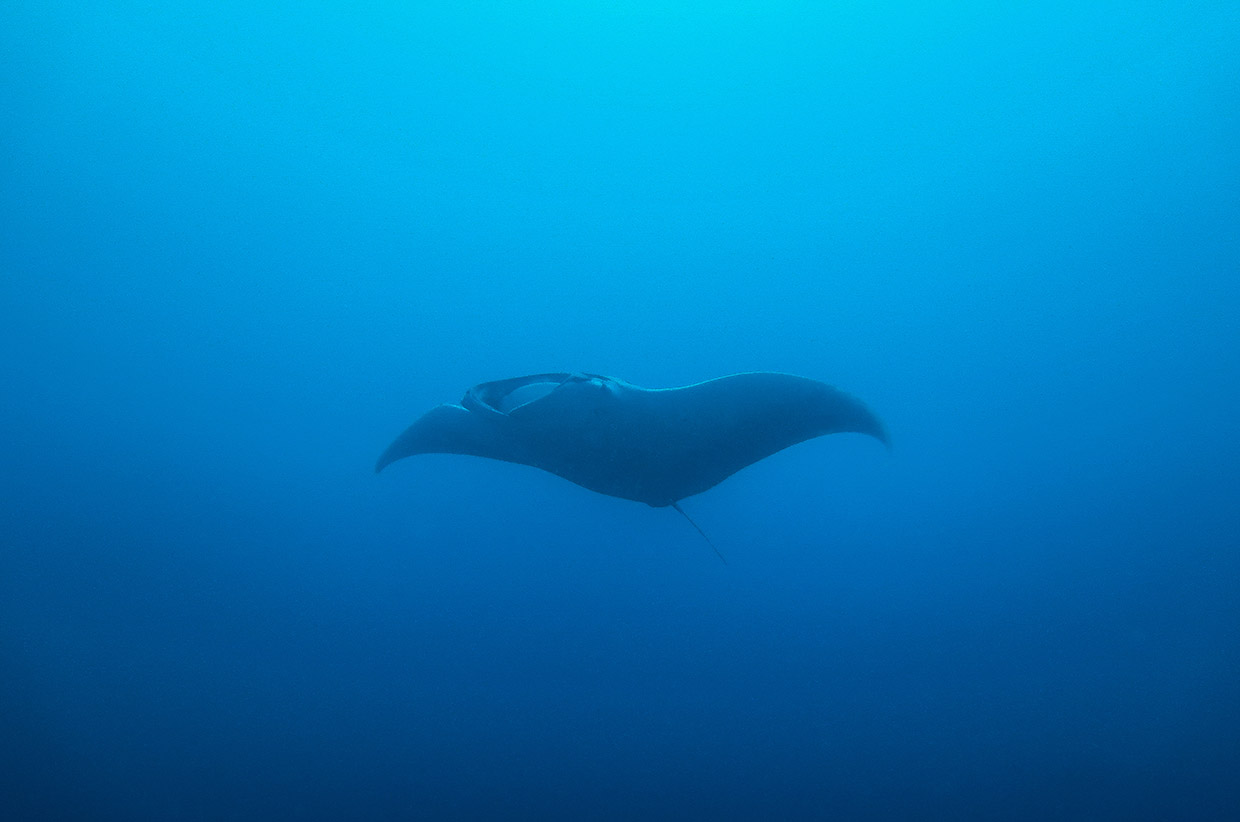
And yet their numbers are being decimated by human causes: entanglements, coastal development, climate change, fisheries. But mostly by Chinese agents who pay poor fishermen in Mozambique, in Ecuador, in Asia, in villages near seas where the manta is known to frequent, to catch and kill mantas. Both the giant manta and the smaller reef manta are listed as vulnerable by the International Union for Conservation of Nature. In the same way that a shark is prized for its fins, the Chinese prize the manta for its gill rakers. Mantas feed by filtering the plankton from water they ingest. The gill plates separate and process the plankton before the water continues on through the gills. Because the Chinese believe that these gill rakers contain miracle cures and health benefits, they add them to their traditional herbal medicines. This belief persists despite no proven evidence – it’s the tragedy of the rhino horn, the tiger penis, the bear gall bladder all over again. But it’s all the more tragically absurd with the manta, as tests done on these gill rakers have shown them to be toxic due to their mercury and lead content. Consumption is slow death.
You try and keep the manta in your view by kicking past and through the rising air bubbles of the other divers. This giant wing just glides on without seeming to move a muscle, travelling in a way that appears simultaneously slow and fast. Sharks, dolphins, whales and fish all give you some sense of the effort it takes to move in the way their tail fins push them through the water. You sense the exertion, even in the grace. The hammerhead in particular is exhausting just to look at. But the manta, without so much as a downward push, easily increases the space and depth between you, and you are forced to give up, level off, and hope it doubles back.
And it does. It banks away and then circles back in pure hydrodynamic grace, rising for another pass at the plankton massing around this lonely black rock and its reef. The manta expert Dr Fabrice Jaine, senior scientist at the Marine Megafauna Foundation, has told you that mantas follow the plankton and can predict where the oceans are at their most productive. Right now this must be the place. Wings pushing, rising, falling, mouth agape, perpetually harvesting – you have time to take this all in now, to savour the moment, and you see the manta in its entirety, striking a balance between massive and fragile. You think you make eye contact, but how, really, can you be certain? Still, you could be forgiven for getting caught up in the exhilaration of the moment.
You move in closer this time, intercepting its trajectory. You turn on your back, looking up as it passes over. It’s harder to suck the air from your tank, but closer, you can see the distinct grey to black patterns that identify this individual. Like snowflakes and fingerprints, no manta has the same pattern. This enables manta researchers to identify them and attempt to trace the extent of their migrations. So on a dive such as this, your photograph of the manta doubles as an entry in the research archive. Through this Ray of Hope Expedition and the Marine Megafauna Foundation there is pattern recognition software to either link your photos to a previously identified manta, thereby adding another bit of data to its profile, or establish it as a new one. In both cases, your contribution is rewarded with a link that will let you keep tabs on this manta whenever it is sighted in the future.
You try and keep the manta in your view by kicking past and through the rising air bubbles of the other divers. This giant wing just glides on without seeming to move a muscle, travelling in a way that appears simultaneously slow and fast.
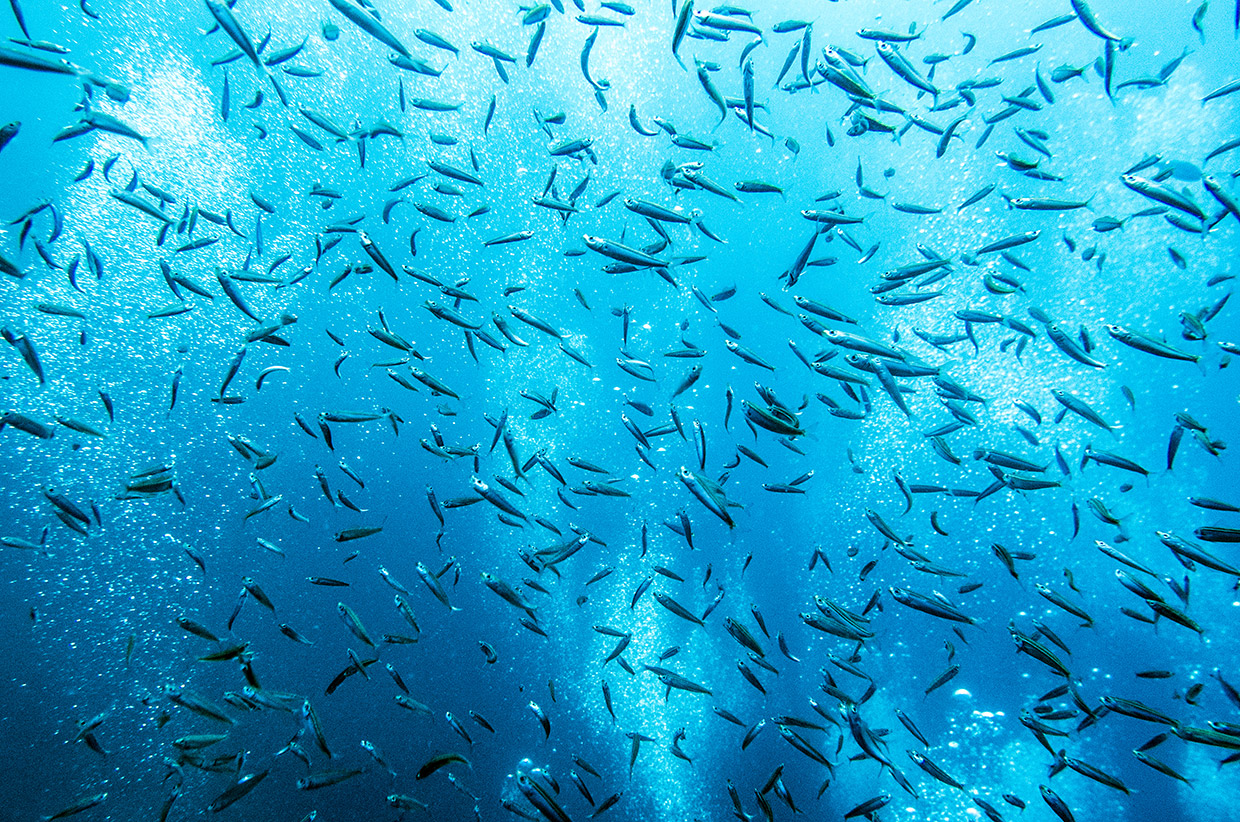
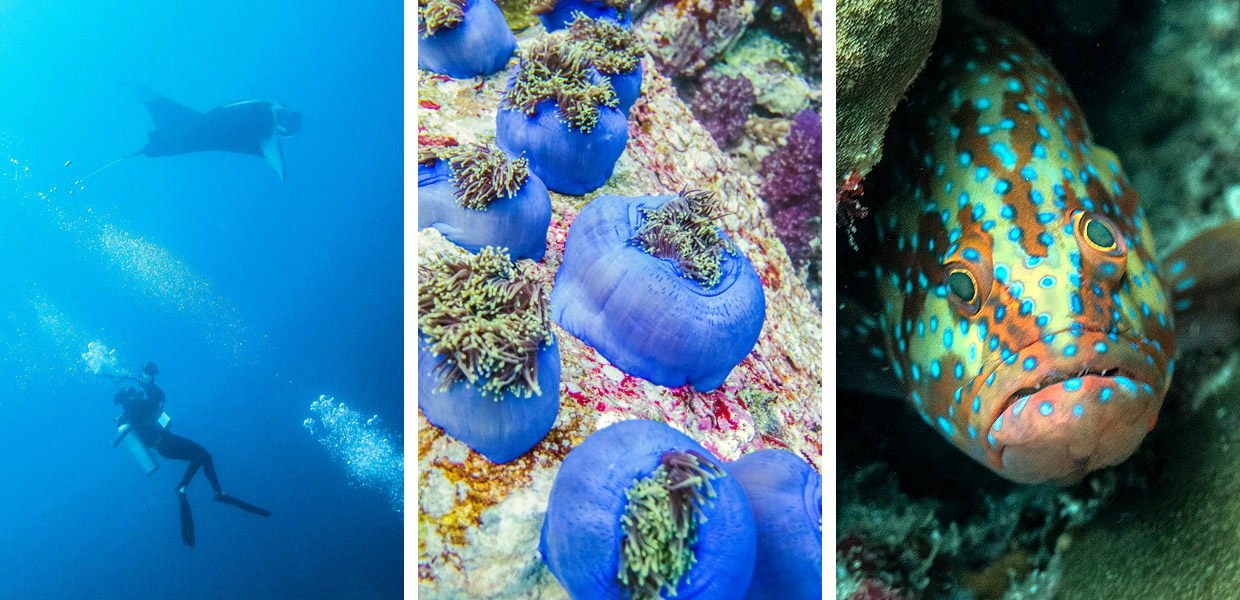
The manta turns back to the void, tantalising, dissolving into midnight. Just like that it has left you and your group, left the reef, left the black rock. Its timing is perfect – come late, leave early, like all the most desired guests.
Despite all the documentaries and related entertainment, we know very little about the manta ray. We know the manta used to be known as ‘the devil fish’ – in some places this name is still in use – on account of the two cephalic fins at the top of the head that can give the appearance of horns. We know the name ‘manta’ comes from the Spanish word for cloak or blanket. You can see why, when viewing a manta from above, you could believe you were watching the devil’s cloak moving across the waters. And you could understand how that might inspire fear.
We know the manta has the largest brain of all fish by absolute weight, likely providing higher sensory capacities. We know its wings are made of thin cartilage, and that the giant manta can likely regulate its core temperature, enabling it to function in deep water. We can spot the gender differences, and know something of their courtship rituals and mating. We know a pregnancy lasts about a year and almost always produces a single pup (twins are extremely rare). We believe the giant manta could live for more than fifty years, we know the approximate extent of their habitat, and that they seem to travel both singly and in small groups. But there are also times and places where they will appear en masse to form the most well-structured underwater feeding frenzy.
We know more than this, of course, but it’s fair to say that the book on mantas is just starting to be written. To study the Manta birostris professionally across the equator’s oceans, like Dr Fabrice Jaine, is to be at the forefront of understanding and conserving this species.
The manta turns back to the void, tantalising, dissolving into midnight. Just like that it has left you and your group, left the reef, left the black rock. Its timing is perfect – come late, leave early, like all the most desired guests.
You ascend now, slowly. Back into the world of light, of full colour, and finally of fresh air. On the boat, the divers are all jacked up. The two in charge of this expedition, Ric Parker and Clive White, know that whatever happens on the rest of the trip, they, by the good graces of this giant manta, have delivered. The mood on the boat is contagious and inclusive.
By the end of the last dive, over a total of eight days of diving in Thai and Myanmar waters, you and the group have seen a total of 14 giant mantas: 12 females, two males. The gender disparity is just one more point for speculation. You’ve also seen a juvenile whale shark – the manta’s closest rival in plankton grazing – and a list of coral, fish, jellyfish, starfish, shark, worms, shrimp, eel, anemone, and other living beings that exceeds three pages in a journal. The four hours not spent underwater or on the boat – a visit and dropping off of eyeglasses, medicine, and reading material for the Moken sea gypsies, and a border crossing through a small Myanmar port town – provide an interlude and contrast to everything seen in the ocean. Both worlds have their draws, their marvels, their mysteries – and their unmistakable signs of environmental damage.
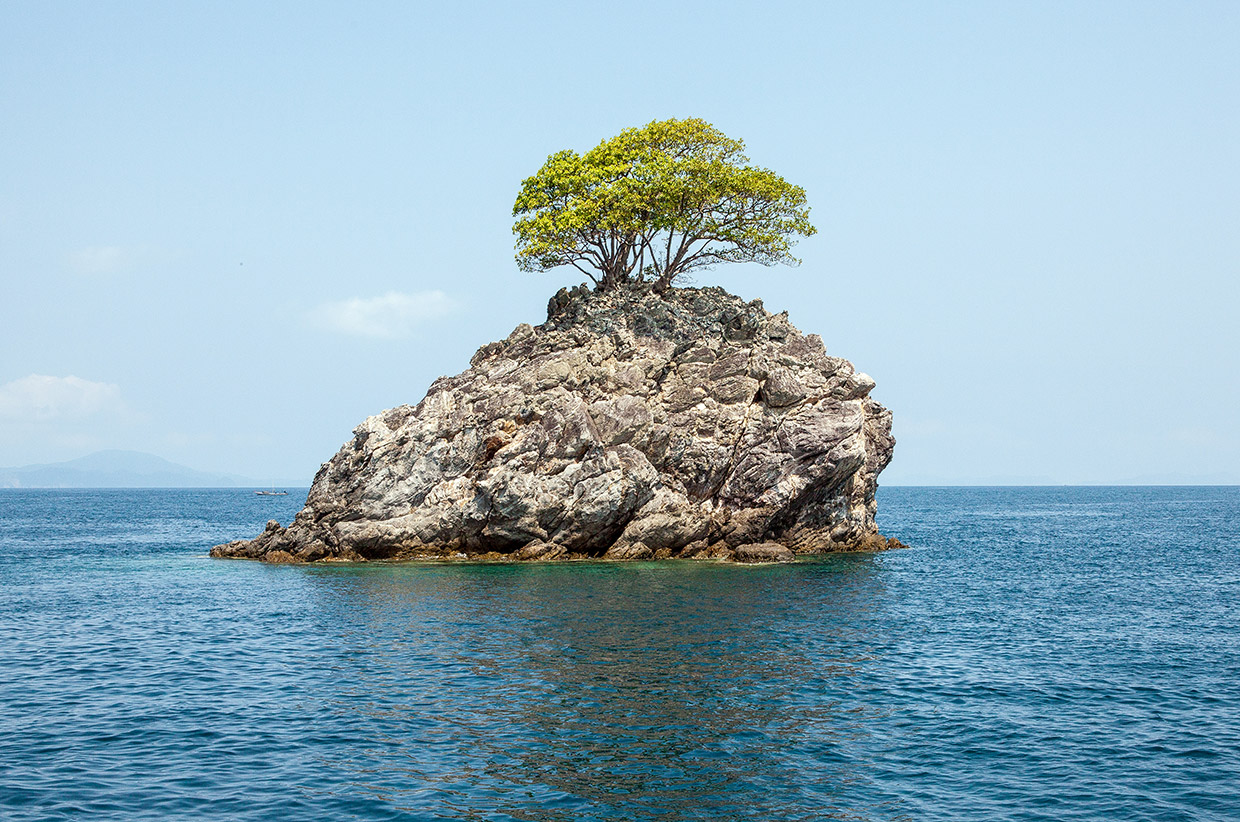
So it goes, and when the rain comes to interrupt a week of sun the next morning, on its way from one remote point to another deep in the Mergui Archipelago, your boat churns past a flotilla of plastic refuse, and you wonder the same questions you wondered about the giant manta: where did it come from, and where will it go?
The end. You find yourself back on land, expedition over, in a modest, clean resort with far too much land but graciously underdeveloped so that there are more palm trees and wide-open spaces than villas. More than half the land is grass and these trees, ordered in rows like a plantation. When you wake in the morning, if you have kept your curtains open to the morning light, the sounds you hear over the cigarette coughs of your neighbours and the white noise of a refrigerator are the songs of iridescent birds. It is a good transition from the boat. You walk outside on sea legs unused to walking more than 10m in a straight line, and you see the morning sun draw silhouettes of the bent palm trunks on the tough St Augustine grass. Morning has broken on land, and it is peaceful.
In a day or so, you will be a ticketed passenger burning time in an airport, one of the multitude – a glassfish – before getting on a jet that lifts you up and off. You’ll sit in the window seat and stare out at that upturned wing tip, slicing through the atmosphere. You’ll arrive when you arrive, either early or late but never on time, and your bags will have an odour of sea sweating out of the rubber and silicone and into the cottons and linens. All the gear will need to be rinsed and dried again before being put away, back in its place, back where it was before all of this happened. As if it had not happened at all. But you have the photos and the still-ripe memories of everything that you saw underwater and on the boat. Of the mantas, the whale shark, of the faces of the divers on the boat and how they transformed behind masks and under the water. You have addresses and business cards. You have the best intentions.
Where do they all go?
Patrick Carpenter is a writer/photographer based in Ho Chi Minh City, Vietnam.
Patrick travels extensively throughout Southeast Asia covering social and environmental issues for international NGOs including UNICEF and IFC/World Bank. You can see more of his photos at www.framingasia.com or patdaneri.tumblr.com, or contact him at [email protected].
Useful Links
Manta Matcher: www.mantamatcher.org
Marine Megafauna Foundation: www.marinemegafauna.org
Dive and Sail Thailand: thailanddiveandsail.com



